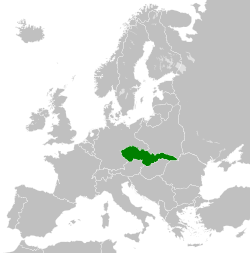
Back Tschechoslowakische Republik (1918-1938) ALS الجمهورية التشيكوسلوفاكية الأولى Arabic بیرینجی چکسلواکی جومهوریتی AZB Першая Чэхаславацкая Рэспубліка Byelorussian Първа чехословашка република Bulgarian Primera República de Txecoslovàquia Catalan První republika Czech Første Tjekkoslovakiske Republik Danish Erste Tschechoslowakische Republik German Πρώτη Τσεχοσλοβακική Δημοκρατία Greek
Czechoslovak Republic Československá republika | |||||||||||||||
|---|---|---|---|---|---|---|---|---|---|---|---|---|---|---|---|
| 1918–1938 | |||||||||||||||
| Motto: Pravda vítězí / Pravda víťazí "Truth prevails" | |||||||||||||||
| Anthem: ’Kde domov můj’ (Czech) ’Where my home is’ ’Nad Tatrou sa blýska’ (Slovak) ’Lightning Over the Tatras’ | |||||||||||||||
 The Czechoslovak Republic in 1938 | |||||||||||||||
| Capital and largest city | Prague | ||||||||||||||
| Official languages | Czechoslovak[1] | ||||||||||||||
| Common languages | |||||||||||||||
| Demonym(s) | Czechoslovak | ||||||||||||||
| Government | Unitary parliamentary republic | ||||||||||||||
| President | |||||||||||||||
• 1918–1935 | Tomáš Masaryk | ||||||||||||||
• 1935–1938 | Edvard Beneš | ||||||||||||||
| Prime Minister | |||||||||||||||
• 1918–1919 (first) | Karel Kramář | ||||||||||||||
• 1938 (last) | Jan Syrový | ||||||||||||||
| Legislature | National Assembly | ||||||||||||||
| Senate | |||||||||||||||
| Chamber of Deputies | |||||||||||||||
| Historical era | Interwar period | ||||||||||||||
| 18 October 1918 | |||||||||||||||
| 28 October 1918 | |||||||||||||||
| 29 February 1920 | |||||||||||||||
| 30 September 1938 | |||||||||||||||
| Area | |||||||||||||||
• Total | 140,800 km2 (54,400 sq mi) | ||||||||||||||
| Population | |||||||||||||||
• 1921 | 13,410,750 | ||||||||||||||
• 1938 | 14,800,000 | ||||||||||||||
| Currency | Czechoslovak koruna | ||||||||||||||
| |||||||||||||||
| Today part of | |||||||||||||||
The First Czechoslovak Republic (Czech: První československá republika; Slovak: Prvá československá republika), often colloquially referred to as the First Republic (Czech: První republika; Slovak: Prvá republika), was the first Czechoslovak state that existed from 1918 to 1938, a union of ethnic Czechs and Slovaks. The country was commonly called Czechoslovakia (Czech and Slovak: Československo), a compound of Czech and Slovak; which gradually became the most widely used name for its successor states. It was composed of former territories of Austria-Hungary, inheriting different systems of administration from the formerly Austrian (Bohemia, Moravia, a small part of Silesia) and Hungarian territories (mostly Upper Hungary and Carpathian Ruthenia).
After 1933, Czechoslovakia remained the only de facto functioning democracy in Central Europe, organized as a parliamentary republic. Under pressure from its Sudeten German minority, supported by neighbouring Nazi Germany, Czechoslovakia was forced to cede its Sudetenland region to Germany on 1 October 1938 as part of the Munich Agreement. It also ceded southern parts of Slovakia and Carpathian Ruthenia to Hungary and the Trans-Olza region in Silesia to Poland. This, in effect, ended the First Czechoslovak Republic. It was replaced by the Second Czechoslovak Republic, which lasted less than half a year before Germany occupied the rest of Czechoslovakia in March 1939.


